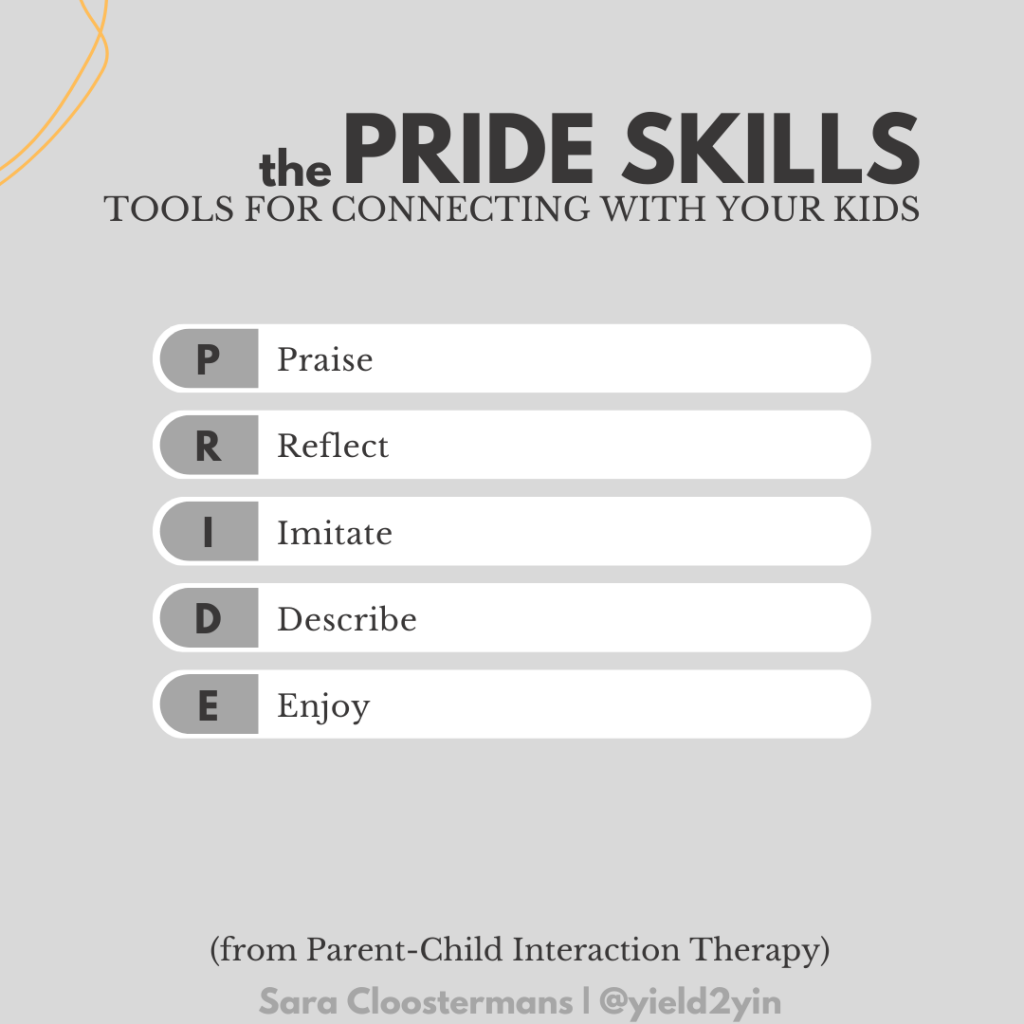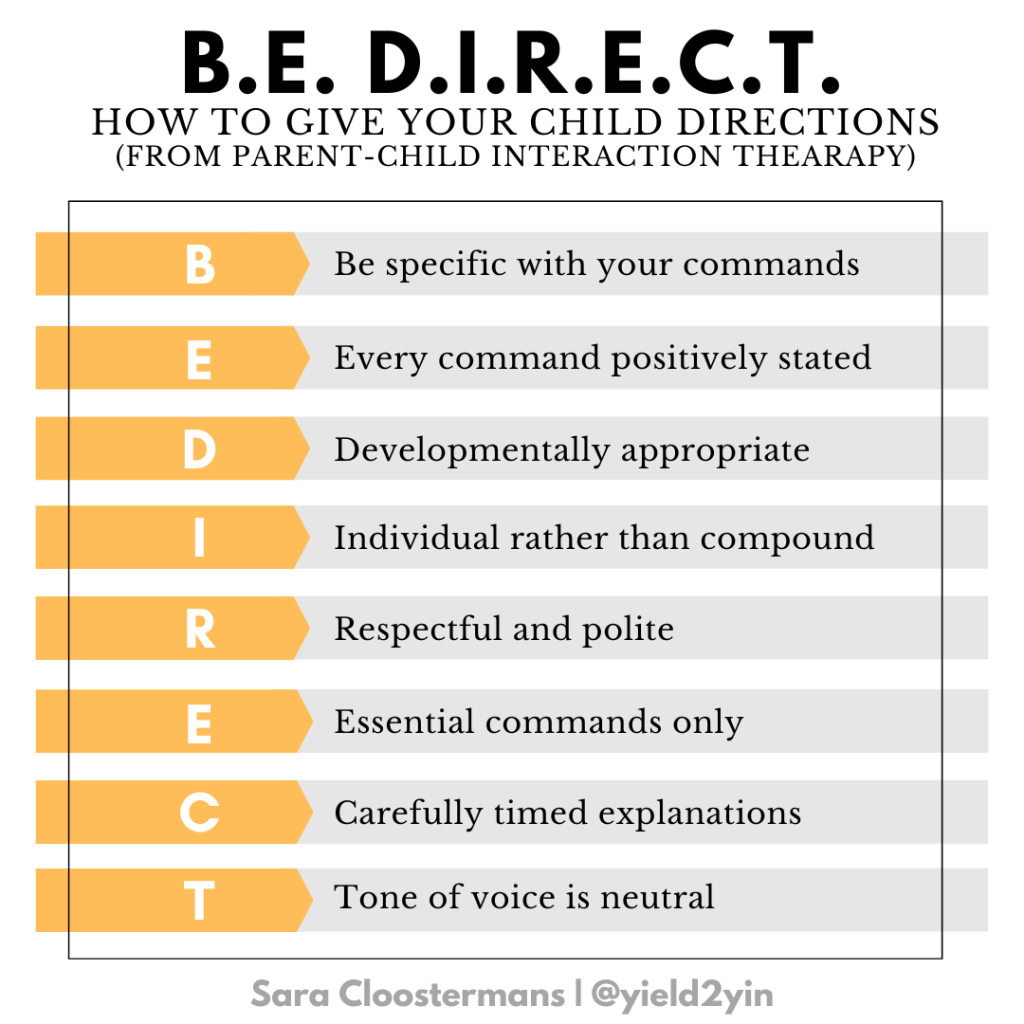For the next few months, I will be writing about different parenting approaches and techniques. Today we’ll begin with Parent-Child Interaction Therapy – a treatment modality first introduced in the 1970s by Sheila Eyberg, Psychologist, and revised several times ever since. PCIT is a user-friendly and effective method for strengthening the bond between parent and child.
At this point in my career, I help my adult clients with their parenting challenges, if that happens to be one of their treatment goals, but I no longer work with children directly.
At the beginning of my therapy career, however, when I was an associate marriage and family therapist at a non-profit child abuse prevention and treatment agency, most of my caseload consisted of children. Whenever I had the chance, and if the grant funding source allowed it, I would also include their parents in our session. This was usually the child’s mother (or foster mother), and sometimes (but rarely) their father.
Being a child therapist was not the direction I would have chosen if it had not been for one of the licensing requirements, which was that a minimum of 500 of the 3000 licensure hours had to be family therapy. Couples’ therapy would have counted toward those 500 hours too, but good luck finding enough couples to meet all those hours.
I was not seeking out work experience with the little ones because I had two of my own at home who kept me quite satisfied in the kid department. Not only that, conducting child therapy had just never been a career aspiration of mine.
Don’t get me wrong, I have always loved my job, including when I was working with children. To better serve them, I even obtained my play therapy certification with UCSD Extended Studies in San Diego. But in general, adult individual therapy is where my heart truly lies.
So why become a “marriage” and “family” therapist if I prefer working with individuals? Well, I graduated from ASU with a counseling degree, not a MFT degree. The original plan was to start working towards licensure in Arizona, yet plans changed (as they do), and my family and I ended up moving to California right after I graduated in 2002.
I felt fortunate to be moving to San Diego because I had always wanted to live there, but I felt extremely unfortunate when, upon my arrival, I found out that California did not provide licensure to counselors AT ALL; only to MFTs and Social Workers. It would not be until the end of 2009 that California would provide licensure to professional clinical counselors.
So, here I was – a new graduate with a Master’s in Counseling – yet no licensing option in my specific field. I contacted the California Board of Behavioral Sciences and learned about the steps I would have to take to become licensed as an MFT. (I chose marriage and family therapy over social work because there is more course overlap between counseling and MFT than there is between counseling and social work).
Over the years, I jumped through all the necessary hoops, and finally became licensed in 2010. Yes, I know, not until EIGHT years after graduation – home for 3 years (adoption process for 2 years + home with the new baby for 1 year), and part-time work for 5 ½ years (collecting the 3000 hours necessary to sit for the licensing exam).
And yes, if you have been paying attention, you noticed that, just before I was ready to sit for the MFT licensing exam in the beginning of 2010, the bill passed at the end of 2009 establishing licensure of counselors in the state of California.
Isn’t it ironic?! Don’t you think?!
I guess the “upside” was that I could now take both exams, which is what I ended up doing. So, I have 2 licenses, which really does not mean a thing.
But I digress.
In the five years that I worked as an associate therapist, I was given the opportunity to participate in an extensive “Parent-Child Interaction Therapy” training, and I took it. I’d love to share some of the principles with you.
What is Parent-Child Interaction Therapy?
Parent-Child Interaction Therapy (PCIT) is an evidence-based treatment for young children with emotional and behavioral disorders. PCIT is a family therapy approach: the children and their caregivers are in sessions together.
The goal of PCIT is to improve the quality of the parent-child relationship and to change the parent-child interaction patterns.
The role of the therapist is to serve as a live coach to the parent as the parent practices the “PCIT skills” with their child during each parent-child interaction therapy session. Typically, this is done with the therapist in an adjacent room with a 2-way-mirror in the dividing wall. The transparent side is in the therapist observation room and the reflective side in the clients’ playroom.
The therapist then coaches the parent through a bug-in-the-ear device. Because I did mostly home visits (and because our devices were often defective), I would instead sit close to the parent and talk to them directly. The children became used to this quickly and most of them did not seem to mind this set-up one bit.
Only a few of them ever asked their parent: “Why do you repeat everything Ms. Sara is saying?” The answer I coached the parents to give was something like: “Ms. Sara is teaching me how you and I can have more fun playing together.” The children were just so excited that their parents were actually playing with them (and one-on-one, nonetheless; typically no siblings allowed) that they would be oblivious to what was happening in their surroundings.
Parent-Child Interaction Therapy: Two Phases
Parent-Child Interaction Therapy has two different phases: the Child-Directed Interaction Phase and The Parent-Directed Interaction Phase. Each phase offers tools that any parent can utilize outside of a therapy setting.
1. The Child-Directed Interaction (CDI) Phase
In the CDI phase, the child directs the play and the parent follows the child’s lead while using the “PRIDE skills.” The PRIDE skills are a series of positive parenting skills that make the child feel seen, heard, accepted, and valued. Learn all about PRIDE skills HERE.

In this phase, the main focus is on enhancing the relationship between the caregiver and the child, and building a deeper connection.
This explains why the CDI phase comes first. Our next phase includes parent commands and limit-setting, but with a deeper connection between parent and child, there is now increased cooperation and compliance. This stronger relationship foundation makes entering the next phase smoother. The child feels less threatened and more secure in the parent-child relationship.
Other benefits of the CDI phase are the child’s increased confidence, focus, and independence. Whether or not you are in a PCIT setting, any parent can benefit from incorporating these skills into their daily life with their kids.
2. The Parent-Directed Interaction (PDI) Phase
In the PDI phase, the child still largely directs the play, but now the parent occasionally gives the child directions.
When giving directions, the parents use a series of strategies that go by the acronym “BE DIRECT”:

If the child complies when given a command, the parent responds with praise every time.
In case of the child’s non-compliance, the following behavior management skills are put into place:
- Time-out
- Logical consequences
- Removal of privileges
In the PDI phase, predictability, consistency, and follow-through are key.
If you want to learn more about the PDI Phase, click here for a link.
When To Move From Child-Directed Interaction to Parent-Directed Interaction?
How do we know that both parent and child are ready to advance from the CDI Phase to the PDI Phase?
For both parent and child to progress from the child-directed interaction phase to the parent-directed interaction phase, the parent has to show “mastery” of the PRIDE skills and within 5 minutes be able to give their child:
- 10 behavioral descriptions
- 10 reflections
- 10 labeled praises
- fewer than 3 questions, commands, and negative talk
Of course, as PCIT therapists, we never expect a parent to use this many skills within 5 minutes in their day-to-day life. Being this attuned to our child(ren) all the time is clearly impossible (and unnecessary).
We have the parent exaggerate the use of the PRIDE skills just in that 5 minute time frame. This ensures that they are as comfortable with the skills as they are with their ABCs. We figure that with this level of parenting “language fluency,” there is an increased chance of “generalization” of skills – being able to use the skills in various other settings outside the play therapy room, such as in their home, at social events, at the playground, and in other public places.
If you open the link, you will see that it says “PCIT for Traumatized Children” on top of the very first page, but really the CDI skills are great to use with any child, not just with children who have a trauma history.
The full treatment typically lasts 6 months (3 months per phase) with weekly 50 minutes sessions. Since I worked with at-risk children only, many families would drop out early because of their complicated life circumstances.
Nevertheless, I was always grateful if we made it through the first phase in which the child leads the play. The parenting skills in the CDI phase, both the PRIDE skills and some of the other PCIT parenting skills, are just so incredibly valuable.
There are some PCIT parenting skills, however, that do not fully align with my “gentle parenting” approach. Therefore, I will be skipping these as I write my future parenting blog posts.
The PCIT parenting skills I will be focusing on are the “PRIDE skills”: Praise, Reflect, Imitate, Describe and Enjoy, as well as the “skills to manage behaviors”: redirect, choices, transitions, rules, when/then statements, calming, and recovery. Some other parenting skills I will touch on are: positive language, selective attention, limit-setting, scheduling worry time, consequences, and skill-building.
Yield2Yin
- Book recommendation: The Whole Brain Child by Daniel Siegel, M.D. and Tina Payne Bryson, Ph.D.
- Mantra: I am CONNECTION // with diaphragmatic breathing
- Yin Yoga Asana: Happy Baby Pose
This page includes Amazon Associate affiliate links. This means I may earn a small commission at no cost to you if you purchase a product I suggest. And for that reason, I only recommend products I believe in. Learn more HERE.







